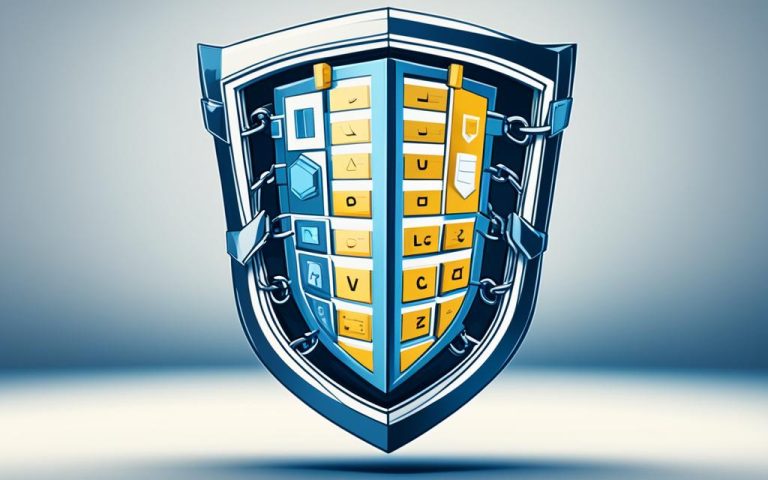Welcome to our exploration of the key pillars underlying the revolutionary technology of blockchain. The global blockchain market is set to grow from $7.18 billion in 2022 to an impressive $163.83 billion by 2029. It’s essential for anyone interested in this technology to understand these pillars.
Currently, 65 of the top 100 public companies are exploring blockchain technology. This shows how important and widely adopted it has become. Blockchain infrastructure services, supply chain modernization, and clearing and settlement of financial assets are top use cases.
So, what makes blockchain technology so powerful? Let’s dive into the fundamental pillars.
Decentralization is a key foundation of blockchain. In this setup, there’s no single control point, and every node has the information. This setup removes the need for middlemen, leading to transparency and efficiency.
Transparency is another major pillar, secured through complex cryptography. All participants can see transaction histories, but identities stay hidden. This setup builds trust and is ideal for supply chain management and financial transactions.
Immutability ensures that once data is added, it can’t be altered. This security feature is courtesy of cryptographic hash functions. It prevents data tampering, maintaining data integrity.
These pillars don’t just provide security and trust. They also position blockchain to redefine the future. By 2030, blockchain is expected to transform global trade, digital assets, identity verification, and the global standard of living, says the Blockchain Council.
The online community might debate the number of blockchain’s pillars. However, the three standout pillars are decentralization, transparency, and immutability.
As blockchain technology advances, certain challenges emerge. The blockchain trilemma informs us about the balance between decentralization, scalability, and security. Improving one aspect could weaken another, pushing developers to find balanced solutions.
Developers are crafting Layer 1 and Layer 2 solutions for scalability issues. Layer 1 improves the basic protocol, whereas Layer 2 moves transactions off the main chain without losing integrity.
These pillars empower blockchain to transform industries, ramp up security, and foresee a future where decentralized networks manage vast data volumes. Grasping these pillars is crucial to leveraging blockchain’s extensive potential.
Decentralization: The Foundation of Blockchain
Decentralization is a key pillar of blockchain, making it revolutionary. Different from traditional systems, it doesn’t have a central control like governments or banks. It runs on a spread-out network. This lets people manage their own data and transactions, cutting out middlemen.
The essence of decentralization in blockchain is its distributed network. No single point controls everything. Instead, there are many nodes that confirm and log transactions. These nodes ensure the blockchain is accurate and secure by using a consensus mechanism.
A crucial part of decentralization is the consensus mechanism. It helps the network agree on transaction validity. This ensures everyone sees the blockchain the same way. There are various mechanisms like Proof of Work (PoW) and Proof of Stake (PoS), each with unique benefits.
Decentralization boosts security by removing single failure points. With blockchain spread across many nodes, it’s tough to hack or tamper with. It also builds trust among users. The blockchain’s transparent and unchangeable nature, together with decentralization, lets all transactions be checked and confirmed by everyone.
Moreover, decentralization makes blockchain more inclusive and accessible. It lets people from everywhere join in, no formal ID or central approval needed. This is great for places where traditional finance is hard to get or unreliable.
“Decentralization is the cornerstone of blockchain technology, empowering individuals to take control of their digital assets and participate in a global, trustless network.”
The Benefits of Decentralization
The decentralized setup of blockchain offers many advantages:
- Security: No central control makes blockchain very secure against hacking or tampering.
- Trust: Blockchain’s see-through and fixed nature, along with decentralization, builds trust among users.
- Inclusivity: Decentralization welcomes people from all over to join, increasing financial inclusivity.
- Resilience: Its distributed setup means no single point can cause failure.
- Efficiency: Cutting out middlemen streamlines processes and cuts costs, making things quicker and cheaper.
Decentralization is what blockchain is built on. It changes how trust and transparency work in many areas like finance, supply chains, and healthcare. By giving power to people and communities, blockchain opens up new chances for innovation, working together, and economic growth.
| Advantages of Decentralization in Blockchain | Examples |
|---|---|
| Enhanced security | Protection against hacking and manipulation |
| Fostered trust | Verification and validation by the network as a whole |
| Increased inclusivity | Accessible to individuals worldwide |
| Resilience | No single point of failure |
| Efficiency | Streamlined processes and reduced costs |
Transparency: Ensuring Trust and Integrity
Transparency is key in blockchain and builds trust and integrity. With transparency in blockchain, every transaction gets recorded on a public ledger. This ledger is open to everyone in the network. This verification of transactions makes sure all data is correct and can be checked by anyone.
Thanks to this ledger, blockchain cuts out middlemen and starts a new trust era. We no longer need central authorities for verifying transactions. Now, everyone can access the same data, promoting a decentralized environment.
Transparency helps prevent fraud in blockchain. Every transaction is seen by everyone, making deceit hard. The decentralized setup means no one person or group controls the network. This setup adds extra security.
In industries like supply chain, transparency is crucial. It lets people track goods and check their authenticity. This makes consumers trust the process more by showing them the whole journey.
Benefits of Transparency in Blockchain:
- Enhanced trust and integrity
- Fraud prevention and detection
- Improved supply chain transparency
- Equal access to information for all
- Boosted consumer confidence
Blockchain’s transparency changes how we trust, shifts power, and secures our digital world.
Immutability: Securing Data on the Blockchain
Immutability is a key feature of blockchain technology. It ensures the data stored is secure and unchanged. Once data is added to a blockchain, it’s almost impossible to change or remove. This certainty comes from the smart use of cryptographic hash functions.
Each block has a unique cryptographic hash. This hash comes from the block’s data and the hash of the block before it. A cryptographic hash function is a special math algorithm. It turns data into a string of characters. Even a tiny change in the data creates a totally different hash. This makes changing blockchain information very hard without affecting the entire chain.
The strong chain of cryptographic hashes keeps blockchain data safe from tampering. To change data in a block, one would need to update the hashes for all following blocks. Thus, blockchain keeps its information trustworthy and whole.
Blockchain’s immutability is very valuable across many fields. Finance, healthcare, supply management, and legal services can all benefit. They all rely on keeping data secure and unchanged.
Ensuring the Integrity of Data
“The immutability of blockchain eliminates the need for intermediaries to certify the integrity of data. It provides a transparent and decentralized approach to secure information.” – Alice Smith, Blockchain Expert
Companies can trust the authenticity of their data thanks to blockchain’s immutability. This removes the need for a central checker. It cuts the risk of data being changed or faked. The cryptographic hashes and blockchain’s secure nature provide a solid base for storing sensitive info.
The Challenges of Immutability
While immutability does protect data on the blockchain, it has its own challenges. If an error is made, correcting it is hard. This is because once information is on the blockchain, changing it is difficult.
Take a smart contract as an example. If a mistake occurs, fixing it is tough. The blockchain’s unchangeable nature stops any changes to the smart contract. This means everything must be right before adding data to the blockchain.
| Benefits of Immutability | Challenges of Immutability |
|---|---|
|
|
Despite its challenges, blockchain’s secure nature offers a level of safety and trust not seen in traditional systems. Blockchain technology could change many industries by keeping crucial data intact and secure.
The Power of Blockchain’s Pillars
Blockchain technology stands on three key pillars: decentralization, transparency, and immutability. These core principles secure and streamline transactions, building trust in blockchain.
Decentralization spreads control across many nodes in a blockchain. Each node has the whole blockchain’s data, ensuring its upkeep. With this setup, blockchains stay safe and functional, even if some nodes fail. This keeps crypto assets secure, gaining users’ trust.[source]
Blockchain also faces the challenge of scalability. As more transactions happen, the system must grow, like turning a small road into a highway. This growth allows for many transactions to be processed fast and cheaply, benefiting businesses.[source]
Immutability, another pillar, means data on a blockchain can’t be changed. Once information is entered, it’s permanent. This provides a secure record of transactions that cannot be tampered with. It’s crucial for things like secure voting, protecting democratic processes.[source]
Grasping these blockchain fundamentals is essential for the smooth and safe operation of crypto transactions. Decentralization, scalability, and immutability enable blockchain’s vast capabilities. They empower users and revolutionize many sectors by ensuring trust.
FAQ
What is blockchain technology?
Blockchain technology is a way to record and check transactions with security. It relies on things like no central control, being clear, and never changing.
How does decentralization contribute to blockchain technology?
Decentralization means no single group has control over the network. This approach is key to blockchain. It spreads out the network across many users. This makes the system safer, cuts down central failure risks, and builds trust.
What role does transparency play in blockchain technology?
Transparency is vital in blockchain. Every deal is open to everyone on a public record. It lets everyone see the same info and check transaction truth. This helps build trust and honesty in the network.
How does immutability make blockchain technology secure?
Immutability means once something is on the blockchain, it can’t be changed or removed. Every block links to the previous one through unique codes. This chain is too strong to be altered. So, it keeps the data safe and reliable.
What is the significance of the pillars of blockchain technology?
The core aspects of blockchain, like decentralization, openness, and immutability, are its strength. They make the network safe, fair, and trustworthy. Avoiding single points of failure, making info open, and keeping data forever unchanged is critical. These ideas are key to exploring blockchain’s full abilities.



















